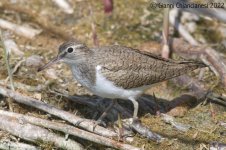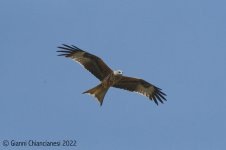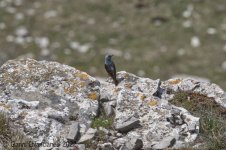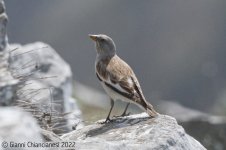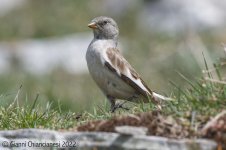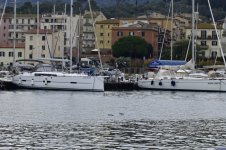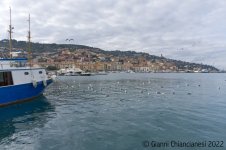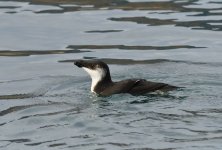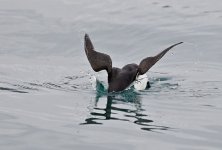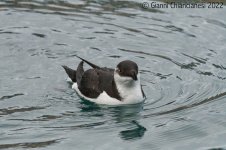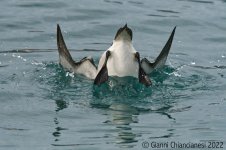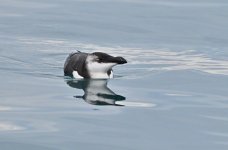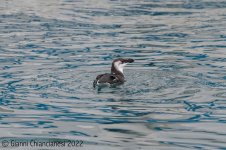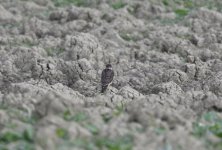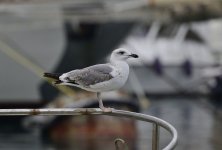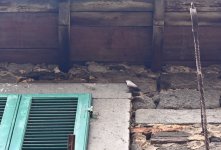-
Welcome to BirdForum, the internet's largest birding community with thousands of members from all over the world. The forums are dedicated to wild birds, birding, binoculars and equipment and all that goes with it.
Please register for an account to take part in the discussions in the forum, post your pictures in the gallery and more.
You are using an out of date browser. It may not display this or other websites correctly.
You should upgrade or use an alternative browser.
You should upgrade or use an alternative browser.
Birding in Southern Tuscany and thereabouts (1 Viewer)
- Thread starter 3Italianbirders
- Start date
More options
Who Replied?
Indeed 👍Congratulations on the Brown Shrike.

thanks folks!

It has been a frantic few days of birding here, all within a radius of less than an hour’s drive from home, but in very different settings.
On the 14th we visited again Lake Montepulciano, hoping for some spring arrivals. Waterfowl were noticeably absent, apart from the usual Mallard, Coot and a couple of pairs of Gadwall. Also Great Crested and Little Grebe. All the herons minus Little Bittern had arrived: Purple, Squacco, Night and Little, plus Cattle Egret and Grey Heron among the residents. Among the warblers Cetti’s, Moustached (lots of those), Great Reed and two passing Garden Warblers. The only wader was a Common Sandpiper and birds of prey included Hobby, Kestrel, Short-toed Eagle and Marsh Harrier. Passerines were very vocal, especially Nightingale, Greenfinch and Blackcap.
On the 14th we visited again Lake Montepulciano, hoping for some spring arrivals. Waterfowl were noticeably absent, apart from the usual Mallard, Coot and a couple of pairs of Gadwall. Also Great Crested and Little Grebe. All the herons minus Little Bittern had arrived: Purple, Squacco, Night and Little, plus Cattle Egret and Grey Heron among the residents. Among the warblers Cetti’s, Moustached (lots of those), Great Reed and two passing Garden Warblers. The only wader was a Common Sandpiper and birds of prey included Hobby, Kestrel, Short-toed Eagle and Marsh Harrier. Passerines were very vocal, especially Nightingale, Greenfinch and Blackcap.
Attachments

Yesterday we met up with birder friends from the US and the Netherlands at Monte Labbro, one of our usual haunts, just on the other side of the mountain from us. At first it looked a bit dead with just the “usual” species: Black Redstart, Red Kite, Cirl Bunting, Linnet, Wheatear, Cuckoo and Stonechat. Also the first Wryneck, Whitethroats and Subalpine Warblers of the year. We tackled the short hike to the summit and while we were looking at the scenery a largish passerine tumbled out of the sky - a brief look through bins before it landed somewhere on our right had us thinking about Snowfinch! A frantic few minutes later we found it foraging between the rocks near the summit and there it was: a Snowfinch in mid-April! (We had seen it here before, ages ago but always in late Autumn or winter).
While we were following the Snowfinch another bird appeared a bit further down: a cracking male Rock Thrush! This is a species that used to breed regularly at this site but that we have only seen during migration in the past few years, so it was a most welcome sight.
We made our way down to the car park (I nearly stepped on a huge Four-lined Snake) and saw that a small flock of Swifts had arrived and was now circling the tower where we had just been: among them we picked out a few House Martins and at least 7-8 Alpine Swift. On the way back home we saw the first Montagu’s Harrier for the year, a female, and thus ended and excellent day of birding.
While we were following the Snowfinch another bird appeared a bit further down: a cracking male Rock Thrush! This is a species that used to breed regularly at this site but that we have only seen during migration in the past few years, so it was a most welcome sight.
We made our way down to the car park (I nearly stepped on a huge Four-lined Snake) and saw that a small flock of Swifts had arrived and was now circling the tower where we had just been: among them we picked out a few House Martins and at least 7-8 Alpine Swift. On the way back home we saw the first Montagu’s Harrier for the year, a female, and thus ended and excellent day of birding.
Attachments

Yesterday we drove down to the coast as friends who had been there had reported on good numbers of waders and a steady flow of migrants. It was also a good excuse to get out of our local patch, having birded mostly within it during the past two years because of Covid restrictions, and we were longing for some serious springtime birding.
The day was blustery and mostly overcast with some patches of sun but the birds didn’t seem to mind. Our destination was the Orbetello lagoon and places nearby, as we planned to bird different habitats to make the most of the day.
Along the way we had lots of Cattle Egret and Yellow-legged Gull, along with a Marsh Harrier and the usual mix of Swallows and Swifts. The first stop was at the Stagnino-Stagnone mudflats, in the north-eastern part of the lagoon, just south of the WWF reserve (only open at weekends), where the first species to greet us was a Hoopoe, followed by the first Woodchat Shrike of the year, Zitting Cisticolas, a couple of Whinchat, a Wheatear and a Little Ringed Plover. This looked good! We set up the scope and started scanning the lagoon: among the Black-headed and Yellow-legged Gulls there were several very smart Slender-billed Gulls (possibly my favourite gull species - among the ones I have seen obvs), scattered all over the place many Greenshank, Dunlin and Kentish Plover in small flocks, a group of Ringed Plover, two excellent Curlew Sandipers, one of them almost in full breeding plumage, and then Curlew, Grey Plover, Little Stint, Black-winged Stilt, and a Green Sandpiper which I flushed when I wandered off looking for passerines. And then there were the terns: Common, Sandwich, Caspian and Gull-billed! We looked everywhere for Little Tern, which would have rounded off things nicely but couldn’t find one - still we couldn’t complain. Other species seen here included Shelduck, Cormorant, Golden Oriole, Crested Lark, Little and Great White Egret, and Grey Heron. At Bosco di Patanella, a couple of kilometres north, we had more Common and Caspian Terns, flyby Sacred Ibis and Spoonbill, Osprey, Hobby, Common Sandpiper and a very nice migrant: Willow Warbler.
We drove halfway up Monte Argentario, the adjoining headland, to a woodland area around a convent with fantastic views (well, on a clear day, ours were somewhat blurred). Here we had another migrant: Collared Flycatcher, plus some nice residents: Serin, Greenfinch, Black Redstart and Short-toed Treecreeper. We moved again, having planned to eat our sandwiches in a lay-by that looked out over the sea. Here we only added a Sardinian Warbler, plus more Yellow-legged Gulls and another Whinchat. Lunch over, we drove around the headland and saw that a few fishing boats were heading back to the nearby port. We set up the scope in another lay-by and surely enough, among the Yellow-legged Gulls following the boat, there were several Scopoli’s Shearwater, some Yelkouans’ and a single Shag. Not bad. The last stop was at the WWF environmental education centre next to the lagoon, where we added to the list Common Redstart, Green Woodpecker, Whitethroat, and a very smart Wood Warbler plus more Greenshank, Black-winged Stilt and a group of Flamingo in the distance.
Time to head back home - the only addition to the list when we were nearly there a nice male Montagu’s Harrier. 72 species altogether, and big grins all around!
No pics of the gulls-terns-waders as they were a bit too far!
The day was blustery and mostly overcast with some patches of sun but the birds didn’t seem to mind. Our destination was the Orbetello lagoon and places nearby, as we planned to bird different habitats to make the most of the day.
Along the way we had lots of Cattle Egret and Yellow-legged Gull, along with a Marsh Harrier and the usual mix of Swallows and Swifts. The first stop was at the Stagnino-Stagnone mudflats, in the north-eastern part of the lagoon, just south of the WWF reserve (only open at weekends), where the first species to greet us was a Hoopoe, followed by the first Woodchat Shrike of the year, Zitting Cisticolas, a couple of Whinchat, a Wheatear and a Little Ringed Plover. This looked good! We set up the scope and started scanning the lagoon: among the Black-headed and Yellow-legged Gulls there were several very smart Slender-billed Gulls (possibly my favourite gull species - among the ones I have seen obvs), scattered all over the place many Greenshank, Dunlin and Kentish Plover in small flocks, a group of Ringed Plover, two excellent Curlew Sandipers, one of them almost in full breeding plumage, and then Curlew, Grey Plover, Little Stint, Black-winged Stilt, and a Green Sandpiper which I flushed when I wandered off looking for passerines. And then there were the terns: Common, Sandwich, Caspian and Gull-billed! We looked everywhere for Little Tern, which would have rounded off things nicely but couldn’t find one - still we couldn’t complain. Other species seen here included Shelduck, Cormorant, Golden Oriole, Crested Lark, Little and Great White Egret, and Grey Heron. At Bosco di Patanella, a couple of kilometres north, we had more Common and Caspian Terns, flyby Sacred Ibis and Spoonbill, Osprey, Hobby, Common Sandpiper and a very nice migrant: Willow Warbler.
We drove halfway up Monte Argentario, the adjoining headland, to a woodland area around a convent with fantastic views (well, on a clear day, ours were somewhat blurred). Here we had another migrant: Collared Flycatcher, plus some nice residents: Serin, Greenfinch, Black Redstart and Short-toed Treecreeper. We moved again, having planned to eat our sandwiches in a lay-by that looked out over the sea. Here we only added a Sardinian Warbler, plus more Yellow-legged Gulls and another Whinchat. Lunch over, we drove around the headland and saw that a few fishing boats were heading back to the nearby port. We set up the scope in another lay-by and surely enough, among the Yellow-legged Gulls following the boat, there were several Scopoli’s Shearwater, some Yelkouans’ and a single Shag. Not bad. The last stop was at the WWF environmental education centre next to the lagoon, where we added to the list Common Redstart, Green Woodpecker, Whitethroat, and a very smart Wood Warbler plus more Greenshank, Black-winged Stilt and a group of Flamingo in the distance.
Time to head back home - the only addition to the list when we were nearly there a nice male Montagu’s Harrier. 72 species altogether, and big grins all around!
No pics of the gulls-terns-waders as they were a bit too far!
Attachments
Last edited:
foresttwitcher
Virtually unknown member

A nice day's birding indeed...

Agreed, impressiveA nice day's birding indeed...

Thanks, it was lots of fun!
SueO
Well-known member
Had me reminiscing. We had a good time in Italy.While we were following the Snowfinch another bird appeared a bit further down: a cracking male Rock Thrush! This is a species that used to breed regularly at this site but that we have only seen during migration in the past few years, so it was a most welcome sight.
We made our way down to the car park (I nearly stepped on a huge Four-lined Snake) and saw that a small flock of Swifts had arrived and was now circling the tower where we had just been: among them we picked out a few House Martins and at least 7-8 Alpine Swift. On the way back home we saw the first Montagu’s Harrier for the year, a female, and thus ended and excellent day of birding.

Razorbills galore!
As reported elsewhere here on BF, the Mediterranean has seen an invasion of Razorbills in the past couple of weeks - they have been reported everywhere, from the Ligurian coast in the NW, to the islands off Sicily and the southern Adriatic sea, with individuals ending up as far as Greece and Algeria - and of course everywhere else in between.
We had been planning to go to the coast for a while, but the weather and family commitments had prevented us until yesterday. We decided to combine the Razorbill quest with a visit to our usual winter haunt at the Diaccia Botrona wetland area and set off westwards when it was still dark.
At our destination we proceeded as usual, driving back and forth along the dirt track that runs along the perimeter of the reserve, looking for birds of prey, Cranes and Geese.
There were LOTS of Cranes, probably several hundred, mostly in the distance, but some permitting good binocular views. The Geese, all Greylag, as far as we could see, although we had been told that there were also some White-fronted, were less numerous, probably around two hundred, mixed with a few Golden Plover.
Birds of prey were ok, although nowhere like last year when we had both Long and Short-eared Owl, Black-winged Kite and Greater Spotted Eagle: at least 4-5 Buzzard, a few Kestrels, a couple female and one male Hen Harrier, then Marsh Harrier, Peregrine, an Osprey and a female Merlin. Not too bad.
Other species included: Flamingo, Spoonbill, Curlew, Grey Heron, Great White and Little Egret, Skylark, Stonechat, Corn Bunting, Avocet, Sacred Ibis, Chiffchaff, Moorhen, Sardinian Warbler and Kingfisher.
Late in the morning we drove to the nearby small harbour of Castiglione della Pescaia to check if the coveted alcids had appeared, but there were only lots of Black-headed Gulls and some domestic ducks and a couple of Kentish Plover on the beach opposite.
Plan B had us heading south on a 40-minute drive to Porto Santo Stefano, a somewhat larger harbour where some Razorbills had been seen in the previous days. We stopped past the ferry landing, scanned the water and, sure enough, there it was: a Razorbill floating in the middle of the harbour. We found a place to park and walked along the western breakwater from where we saw that the birds were in fact two, and that there were another five on the far side, where the fishing boats docked. We got in the car again and drove back the way we had come, parked right by the dockside and there they were, feeding on the scraps thrown overboard by the fishermen, among Yellow-legged Gulls in all the moults you can conceive (and also those in between), close enough to take decent record shots with my 70mm lens.
We ended up staying there until it was time to leave, with a short break for lunch at a spot where we always go for sea-watching, but the sea was pretty calm and there was nothing to see, apart from a very smart Little Egret and a Common Sandpiper along the way. We had tremendous fun watching the Razorbills dive and feed among the whirlwind of Gulls (and the occasional Shag); we had seen them before in Scotland, but never this close. Several dead ones have been found along the coast, north and south, but we were lucky and only saw them alive and very much kicking.
Just before heading home we stopped along the promenade just past the harbour to check if anything interesting was tailing the fishing boats returning to port, adding a few Yelkouan’s Shearwater to the day’s tally.
Pics below:
The first glimpse of the Razorbills
on the other side of the harbour among the gulls
As reported elsewhere here on BF, the Mediterranean has seen an invasion of Razorbills in the past couple of weeks - they have been reported everywhere, from the Ligurian coast in the NW, to the islands off Sicily and the southern Adriatic sea, with individuals ending up as far as Greece and Algeria - and of course everywhere else in between.
We had been planning to go to the coast for a while, but the weather and family commitments had prevented us until yesterday. We decided to combine the Razorbill quest with a visit to our usual winter haunt at the Diaccia Botrona wetland area and set off westwards when it was still dark.
At our destination we proceeded as usual, driving back and forth along the dirt track that runs along the perimeter of the reserve, looking for birds of prey, Cranes and Geese.
There were LOTS of Cranes, probably several hundred, mostly in the distance, but some permitting good binocular views. The Geese, all Greylag, as far as we could see, although we had been told that there were also some White-fronted, were less numerous, probably around two hundred, mixed with a few Golden Plover.
Birds of prey were ok, although nowhere like last year when we had both Long and Short-eared Owl, Black-winged Kite and Greater Spotted Eagle: at least 4-5 Buzzard, a few Kestrels, a couple female and one male Hen Harrier, then Marsh Harrier, Peregrine, an Osprey and a female Merlin. Not too bad.
Other species included: Flamingo, Spoonbill, Curlew, Grey Heron, Great White and Little Egret, Skylark, Stonechat, Corn Bunting, Avocet, Sacred Ibis, Chiffchaff, Moorhen, Sardinian Warbler and Kingfisher.
Late in the morning we drove to the nearby small harbour of Castiglione della Pescaia to check if the coveted alcids had appeared, but there were only lots of Black-headed Gulls and some domestic ducks and a couple of Kentish Plover on the beach opposite.
Plan B had us heading south on a 40-minute drive to Porto Santo Stefano, a somewhat larger harbour where some Razorbills had been seen in the previous days. We stopped past the ferry landing, scanned the water and, sure enough, there it was: a Razorbill floating in the middle of the harbour. We found a place to park and walked along the western breakwater from where we saw that the birds were in fact two, and that there were another five on the far side, where the fishing boats docked. We got in the car again and drove back the way we had come, parked right by the dockside and there they were, feeding on the scraps thrown overboard by the fishermen, among Yellow-legged Gulls in all the moults you can conceive (and also those in between), close enough to take decent record shots with my 70mm lens.
We ended up staying there until it was time to leave, with a short break for lunch at a spot where we always go for sea-watching, but the sea was pretty calm and there was nothing to see, apart from a very smart Little Egret and a Common Sandpiper along the way. We had tremendous fun watching the Razorbills dive and feed among the whirlwind of Gulls (and the occasional Shag); we had seen them before in Scotland, but never this close. Several dead ones have been found along the coast, north and south, but we were lucky and only saw them alive and very much kicking.
Just before heading home we stopped along the promenade just past the harbour to check if anything interesting was tailing the fishing boats returning to port, adding a few Yelkouan’s Shearwater to the day’s tally.
Pics below:
The first glimpse of the Razorbills
on the other side of the harbour among the gulls
Attachments
Last edited:

More Razorbill pics. Love it when they dive!
Attachments



Thanks Mike!

Wallcreeper! (Which I didn't see 😐)
This morning it was drizzling and I was getting ready to go out and run some errands around town when G, who had gone out 20 minutes earlier to try out a new lens, called to say that he had just seen a Wallcreeper in the old town, but then it had flown while he was fiddling with his camera and he wasn't able to locate it again. I joined him in 10 minutes and we walked for a while down the alleys in the town centre, but we had no luck. Still, he had been able to snap a couple of pics with a 135mm lens and of course we'll try again although the old town is pretty big, so it's a needle in a haystack kind of thing. Fingers crossed, and Happy New Year everyone!
This morning it was drizzling and I was getting ready to go out and run some errands around town when G, who had gone out 20 minutes earlier to try out a new lens, called to say that he had just seen a Wallcreeper in the old town, but then it had flown while he was fiddling with his camera and he wasn't able to locate it again. I joined him in 10 minutes and we walked for a while down the alleys in the town centre, but we had no luck. Still, he had been able to snap a couple of pics with a 135mm lens and of course we'll try again although the old town is pretty big, so it's a needle in a haystack kind of thing. Fingers crossed, and Happy New Year everyone!
Attachments

Thank you dragnil! And to you too!
Similar threads
- Replies
- 6
- Views
- 880
Users who are viewing this thread
Total: 2 (members: 0, guests: 2)






